What is better for the kitchen - tile or linoleum. What is better tile or linoleum
Choosing flooring material for your kitchen can be tricky. Many people want to show their design talent and, for the sake of fashion, put them in the kitchen modern coatings: natural cork, self-leveling floors with artistic prints, etc. However, most of these materials are quite expensive, characterized by complex installation. In addition, it is still unknown how this or another novelty will behave in a kitchen where temperature and humidity regularly rise.
Therefore, the most far-sighted owners decide to put time-tested materials in the kitchen: ceramic tiles or linoleum. Which of these covers is the best? Let's try to understand this issue by comparing these two materials according to the most important criteria necessary in difficult kitchen conditions.
Criterion #1. wear resistance
The kitchen is one of the most visited rooms in the house. According to some reports, a nimble housewife walks through the kitchen for about 2 km a day! To withstand such loads, the floor must be as wear-resistant as possible. Otherwise, visible worn places and scratches will appear on it in a couple of months.
In general, the wear resistance of tiles is more than high level than linoleum. To on ceramic surface scratches and worn places appear, it is necessary to make significant efforts or operate the tile for decades. Tiles are divided into several classes according to wear resistance. For the kitchen, it is desirable to select material with markings of 3-5 classes.
Wear resistance gradation also exists for linoleums. Choosing linoleum over high class, you can almost equal the wear resistance of linoleum and tiles.
Depending on the class, linoleums are divided into:
- household - classes 21-23;
- semi-commercial - classes 31-34;
- commercial - classes 41-43.
Household classes of linoleums are intended for residential premises, semi-commercial - for offices and various institutions, commercial - for industrial premises. However, all these divisions are rather conditional. "According to the rules" household linoleums of class 22-23 are suitable for the kitchen. But, in order to increase the durability of the coating, professionals recommend increasing the wear resistance class and choosing linoleum for the kitchen from the range of semi-commercial or commercial linoleums.
Criterion #2. moisture resistance
Second important requirement to coatings in the kitchen - moisture resistance. The fact is that here periodically something is cooked and dishes are washed, respectively, the humidity of the air is very high. Moisture droplets in the air act on the floor surface and settle on it. Since water is constantly used in the kitchen, spilling it is a frequent occurrence. In other words, the flooring in the kitchen must withstand high humidity(in the form of condensate, standing puddles): do not swell, do not crack, do not deform.
Linoleum does not absorb liquid, so condensation, wet air and even spilled liquid will not harm him. However, if a flood occurs (for example, you are flooded by neighbors from above) and water gets under the linoleum, then deformation of the coating (swelling) is possible. Another perspective in this situation: the appearance of mold and fungal infection under wet linoleum. To avoid this, the coating will have to be removed and dried.
Moisture resistance of tiles is at a higher level. If we remember that even pools are tiled, we can conclude that this material is absolutely moisture resistant. And even a flood and a bay by neighbors will not cause any harm to the tiles!
Criterion #3. Rich assortment
The assortment of linoleum and tiles in stores is simply huge. The variety concerns both the types of coatings and their colors, textures, characteristics and features of operation.
There are two types of PVC linoleum: homogeneous and heterogeneous. Homogeneous is a single-layer polyvinyl chloride layer with a pattern throughout its thickness, protected from above by a thin layer of transparent polyurethane. Heterogeneous linoleum is a multilayer material consisting of several layers of PVC, stabilizing fiberglass (glass mesh) and a protective transparent layer of vinyl and polyurethane. For the kitchen, you can use both types of PVC linoleum.
In addition to PVC rolls, you can find on the market (although much less often!) Natural linoleum - marmoleum. This is a completely natural material, in the manufacture of which a compressed mixture of linseed (or soybean) oil, tree resin, crushed cork or wood flour, limestone is applied to a jute base. In addition to its naturalness, and therefore harmlessness, marmoleum has many other useful qualities, which are not inherent in PVC linoleum. For example, antiseptic and fungicidal properties that protect the floor surface from the growth of harmful bacteria and fungi on it. Accordingly, marmoleum is very hygienic. Also, natural linoleum is resistant to solvents, fats, ethyl alcohol, non-concentrated acids. In addition, it is fire resistant. Unfortunately, none of these qualities can be attributed to ordinary PVC linoleum. Its only winning feature is more low price. The cost of marmoleum of some brands can reach the price of elite parquet!
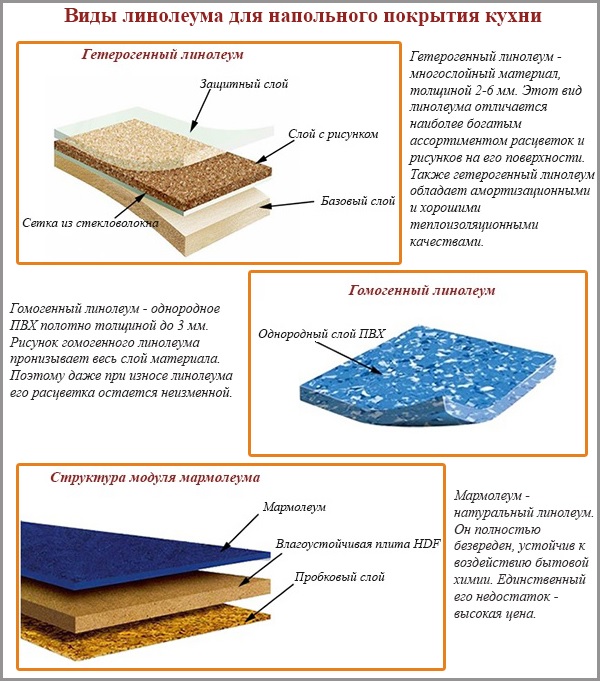
As for the colors of linoleum, there is plenty to choose from: a full range of "pure colors"; marble coloring; various drawings; patterns imitating parquet, tiles, leather, stone, etc. As a rule, these are heterogeneous synthetic linoleums. The range of colors of homogeneous linoleums is much more modest - it is either solid color, or marble spotting. Marmoleums, as a rule, are also monophonic or with patterns in the form of spots, streaks. Sometimes there are collections that imitate other materials, such as crocodile skin.
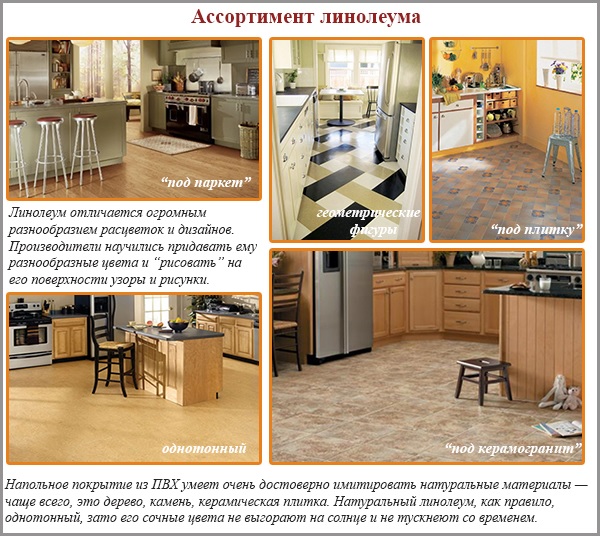
The tile does not lag behind in diversity from linoleum. It can be matte or glossy different sizes and flowers. Often its surface is decorated with drawings or patterns. Many modern collections consist of tiles that, when laid, form one large pattern, such as a poppy field or a panel of frolicking butterflies.
The ability of ceramic tiles to imitate other materials is limitless. Tiles are produced almost indistinguishable from parquet, metal, fabric, natural leather. Moreover, not only the pattern of these materials is imitated, but also the texture.
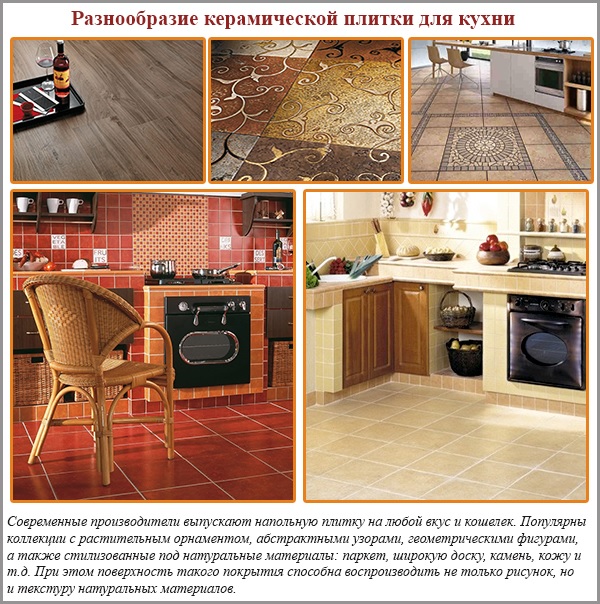
Criterion #4. impact resistance
Impact resistance - forte linoleum. If you drop a pot, glass or plate on it, then nothing will happen to the coating. Linoleum will not break or crack. The only thing he is afraid of is sharp objects, such as knives or forks. Such items can leave punctures or cuts on the linoleum.
Tile, on the other hand, is a fragile material. A heavy object dropped on it, such as a hammer, is more likely to cause cracks and chips.
Criterion #5. Resistance to mechanical stress
Linoleum is a material appearance which is easily damaged by mechanical action. On it there are cuts from fallen knives and forks, scratches from the claws of a cat or unsuccessfully moved furniture. Also, there is no escape from dents - traces of studs, legs kitchen furniture and technology. Therefore, when choosing linoleum, you need to pay attention to the thickness of its protective layer. The thicker it is, the more stable the linoleum will be.
As for tiles, this material is denser and harder, does not change its shape under the influence of external factors. Therefore, unlike linoleum, it is impossible to leave dents from heels or furniture legs on it.
Criterion #6. Ease of care, hygiene
Sometimes the floors in the kitchen have to be washed several times a day. Therefore, they are simply obliged to have dirt-repellent abilities and in no case accumulate dust and debris in themselves. Kitchen floors should require minimum care to keep clean.
Caring for linoleum and tiles is equally easy. These materials are easily washed from household contaminants. Dust, street debris, grease splashes or household chemicals Everything stays on the surface. And to remove all unnecessary, it is enough to wash the floor and rub the too dirty places with a soft cloth. To care for tiles and linoleum, there are rulers specialized funds, but, in fact, the owners of floors made of these materials wash them with plain water with the addition of any household cleaner.
It should be noted that in order to increase hygiene, some brands of PVC linoleums are impregnated with antibacterial and antifungal compounds. This does not mean that such material is self-cleaning, but the reproduction of bacteria and fungi that have fallen on it slows down significantly. Compared to artificial linoleum, marmoleum does not need any impregnation at all. It initially contains substances with bactericidal and fungicidal action, that is, it is a kind of antiseptic.
Criterion #7. Operating comfort
Linoleum is “warm” to the touch, it is pleasant to walk on it barefoot. Moreover, the thicker the material, the more heat it retains. The most comfortable in this regard, linoleums with a substrate - on PVC foam, jute or felt base. For wet kitchens, it is better to choose foam-based linoleums. Such a substrate is not afraid of water, unlike natural jute and felt.
The tile, on the contrary, has a cold surface, so it is not comfortable to walk on it in winter. There are two ways out of this situation. You can cover the cold floor with rugs and rugs. Or apply a more radical method - lay a warm floor system under the tiles. When it is turned on, the temperature of the tile will be maintained within a comfortable range for a person.
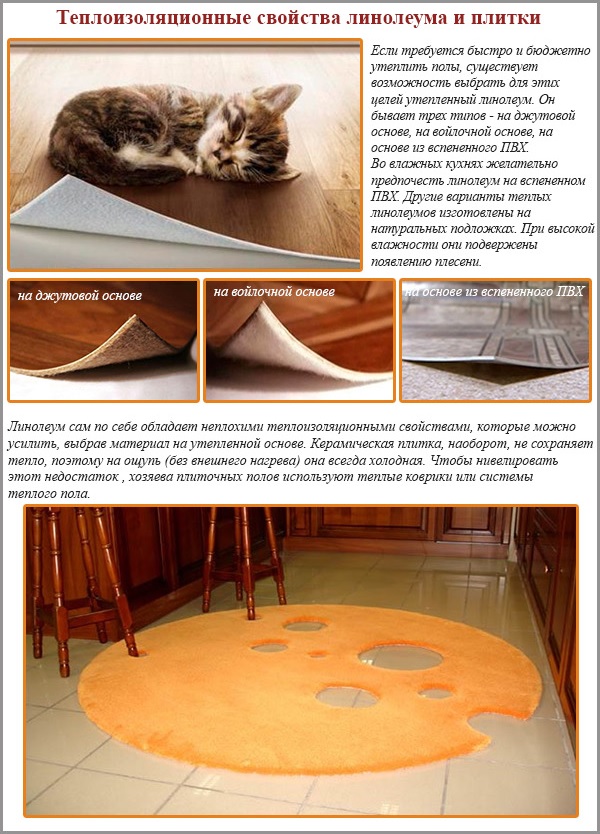
Criterion #8. Compatibility with underfloor heating system
The tile has low thermal insulation properties, so it conducts heat very well. Heating elements laid under floor surface, they will transfer all their heat to the tile, and she, in turn, to the kitchen.
The thermal insulation properties of linoleum are higher, in addition, PVC coatings are capable of releasing harmful substances when heated. Therefore, not every linoleum can be laid on top of water and electric underfloor heating systems. Permission to use a particular product is indicated on the packaging in the form of markings. So that linoleum in this case does not work as a heat insulator, you should select thin material without insulating lining.

Criterion #9. Heat resistance
The tile is resistant to both heat and temperature extremes. Linoleum can not be heated above 28-30 ° C. Therefore, when laying linoleum on top of a warm floor, it is necessary to provide the system with a thermostat. In case of non-compliance temperature regime it is possible to change the degree of coloring of the coating in places of heating. If something hot falls on the linoleum (a hot frying pan, for example), then its surface will melt and unsightly marks will remain.
Criterion #10. Resistance to chemicals, aggressive environments
According to this criterion, of course, ceramic tiles are in the lead. Grease stains or puddles of household chemicals used in the kitchen do not corrode the surface of the tile and do not change its color. Linoleum is much more capricious. Aggressive substances that fall on linoleum are poorly washed. Some of them (alkali, acid) are able to corrode the upper protective layer and leave behind stains, stains, bald spots.
Criterion #11. Burn-out resistance
If linoleum is laid in solar kitchen, after a couple of years, you can notice a significant tarnishing of its color and pattern. This drawback does not apply to marmoleum.
Unlike linoleum, tiles do not change color when exposed to intense sun rays. No wonder some types of ceramic tiles (with increased frost resistance and wear resistance) are used for facing outdoor objects - terraces, patios, open areas.
Criterion #12. Naturalness and environmental friendliness
Ceramic tiles are produced by pressing from kaolin clays with the addition of dyes. PVC linoleum is made from synthetic polyvinyl chloride. Marmoleum (natural linoleum) - made from linseed oil and tree resin, fixed on a jute base. In other words, tiles and marmoleum are natural and entirely safe materials. Synthetic linoleum loses in this regard. It is especially unpleasant that it is able to evaporate polyvinyl chloride when overheated.
Criterion #13. Ease and speed of installation
The installation process of linoleum usually does not require the involvement of professional craftsmen and is done independently. On the standard kitchen Laying linoleum takes 1-2 hours.
Tiles are much more difficult to work with. To perform the installation of tiles, certain skills are required. Therefore, often specialists are involved in these works, who perform the lining of the kitchen floor, on average, in 1 day.
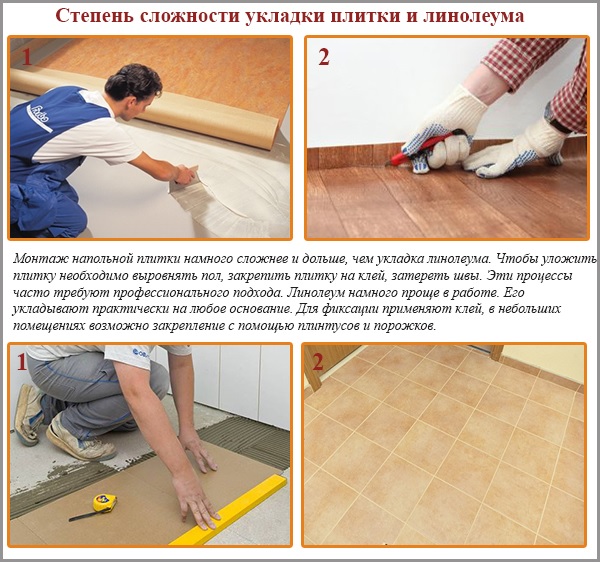
Criterion #14. Price
Synthetic linoleum is one of the most inexpensive materials for the floor. This is its huge advantage over tiles. However, this applies only to artificial linoleums. Marmoleum is an expensive material and can give odds in price not only to tiles, but also to wooden parquet.
Conclusions - which is right for you?
As a result, we can conclude: both tiles and linoleum are great for the kitchen. However, linoleum will almost certainly prove to be a more budget-friendly and safer (non-traumatic) option, albeit less durable. At the same time, when worn, it is easy to replace with a new one. Tiles are expensive both at their own price and at the cost of installation. However, its use is longer term. It lasts longer than linoleum, retains its original appearance, wears out less.
Therefore, choose the material that suits you in specific conditions. In some cases, both options are combined. The working area subjected to the greatest loads is tiled, and dining area- covered with linoleum.
To find out what better tile or linoleum in the kitchen, you need to determine the advantages and disadvantages of each floor covering.
Characteristics of linoleum
Linoleum flooring for the kitchen has its pros and cons.
The advantages of linoleum:
- Multilayer linoleum is on the market building materials great variety of patterns and colors. You can always find the perfect fit for the design of the kitchen in which the flooring is being installed.
- For the price, linoleum is a fairly cheap material. Every average buyer can buy it.
- Installation of linoleum is simple. Any person who does not have the required knowledge and work experience can install this floor covering.
- Cleaning linoleum is very easy. It is enough to wipe it with a wet cloth.
- Walking on linoleum is much more pleasant than walking on tiles. This flooring is warm.
- Linoleum is a durable material. There are commercial and household linoleum. The material, which is intended for laying flooring in enterprises, is designed to be used for decades.
Disadvantages of linoleum:
- If a lot gets on the floor in the kitchen sunlight, the material will burn out. It will lose its rich color.
- Linoleum is not protected from sharp objects. You can not walk on it in stilettos, as well as drop sharp objects. The floor covering can be easily cut from them.
- Stains from paint, grease and chemical substances difficult to remove from linoleum.
Tile characteristics
Ceramic tiles are suitable for kitchen flooring. However, this material also has its pros and cons.
Benefits of tiles:
- Ceramic tiles have a long service life. It is much larger than that of linoleum.
- Among the tiles there is a wide variety of colors and patterns.
- Ceramic is resistant to temperature changes. It will not deteriorate even in the event of a temperature jump, which often happens in the kitchen during the operation of household appliances.
- The tiles are resistant to water penetration. You can spill liquid on such a floor and nothing will happen to it.
- Ceramics can be cleaned with chemical detergents. They will help to cope with any stains.
Disadvantages of tiles:
- Ceramic tiles are cold flooring. This problem can be corrected only by installing a "warm floor" system.
- Price for quality tiles high enough. Not every buyer can afford to buy it.
- Installing tiles is difficult without certain knowledge and experience.
- Grouting between tiles is often moldy. From this, she quickly loses her attractive appearance. It needs to be looked after to prolong its service life.
- Tiles are considered unsafe flooring. You need to be extremely careful with spilled water, on which you can easily slip.
findings
Ceramic tiles for the kitchen are much better than linoleum. It is more reliable and durable. But it is better to purchase matte material, rather than glossy. Such tiles are not slippery and traumatic.
The kitchen is one of the rooms in the house where the hostess spends a lot of her time. Here you can meet friends and family dinners, and the birth of culinary masterpieces, and morning awakening with a cup of aromatic coffee in the rays of the rising sun. That is why it is so important to make the kitchen room not only beautiful, but also cozy. So that you can walk barefoot on the floor of the kitchen, and not shudder from the cold of the tile. Therefore, we suggest choosing linoleum as a floor covering for the kitchen floor. Moreover, laying such material is not difficult.
Important: unlike tile and laminate, linoleum is absolutely not afraid of heavy dishes falling from any height. Anything can happen in the kitchen!
Types of linoleum
If you decide to abandon the laminate or tiles in the kitchen, and decided to lay linoleum, then you should know that this flooring can be of two types. They are divided according to the material used in the production of linoleum.
- Synthetic. Made from polyvinyl chloride using synthetic fibers. And although such a coating is considered cheaper, unlike laminate or tile, it can still be successfully used in the kitchen. Especially if the thickness of the upper protective layer will be from 0.4 to 0.6 mm. According to experts, PVC linoleum, made in accordance with GOST, fully complies sanitary standards. And accordingly, it can be laid in the kitchen and all living quarters.
- natural linoleum. This product is made on the basis of natural tree resins, flax oil, cork or wood flour with the addition of natural coloring pigments. This flooring is environmentally friendly, durable, wear-resistant and resistant to various aggressive detergents. Good natural linoleum is not inferior in quality to tiles or laminate. Moreover, the service life of such a coating sometimes even exceeds the service life of the laminate and reaches 40-50 years.
Important: it is easy to distinguish between natural and synthetic linoleums in the store. It is enough to look at back side coatings. Natural linoleum has a base in the form of linen or jute fibers. Synthetic has a felt base. In addition, natural linoleum smells like linseed oil and natural materials, while the synthetic coating emits a synthetic smell.
Linoleum: multilayer or single layer
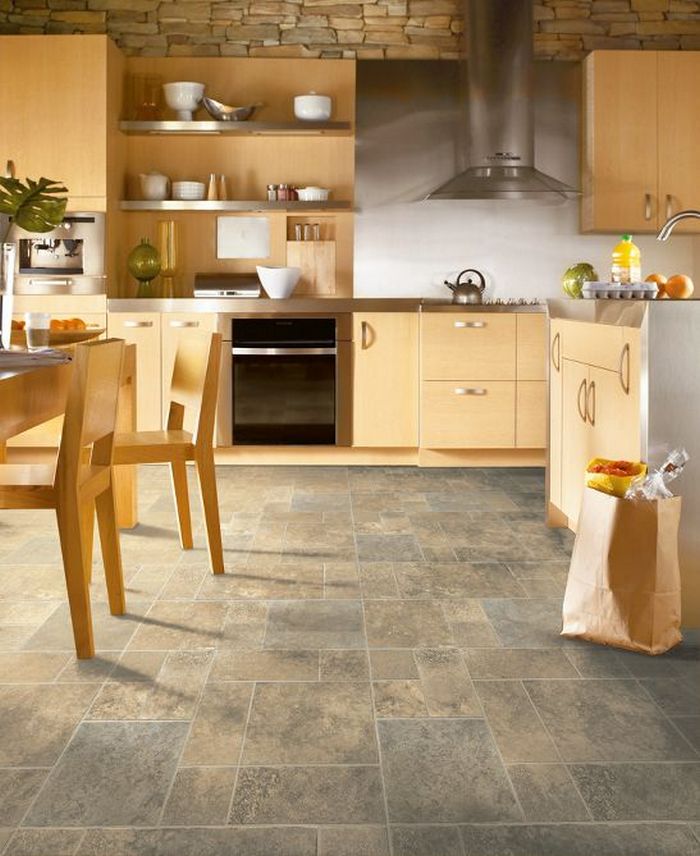
If you abandoned tiles and laminate in the kitchen, and decided to lay linoleum, then you should also know that such flooring can be single-layer and multi-layer (in professional circles this is called homogeneous or heterogeneous linoleum).
- Homogeneous linoleum performed in one layer according to the rolling principle pvc material. A feature of this flooring for the kitchen is its pattern, which penetrates the entire thickness of the material. That is, in the process of wear and tear, homogeneous linoleum will not form faded spots on its surface. Its pattern for tiles, laminate, etc. will remain unchanged. Such a PVC floor covering serves from 5 to 8 years.
- heterogeneous linoleum has several layers in its structure. This is the base, PVC foam with a pattern on it and the top protective thin layer. Here, the coating is evaluated by the thickness of the layer with the pattern and by the thickness of the base substrate. The larger the first parameter, the less prone to wear and abrasion will be linoleum. BUT big thickness base allows you to provide thermal insulation in the room and good cushioning of the coating. A significant drawback of heterogeneous linoleum is its ability to sag under the legs of heavy furniture.
Wear resistance of the coating for the kitchen
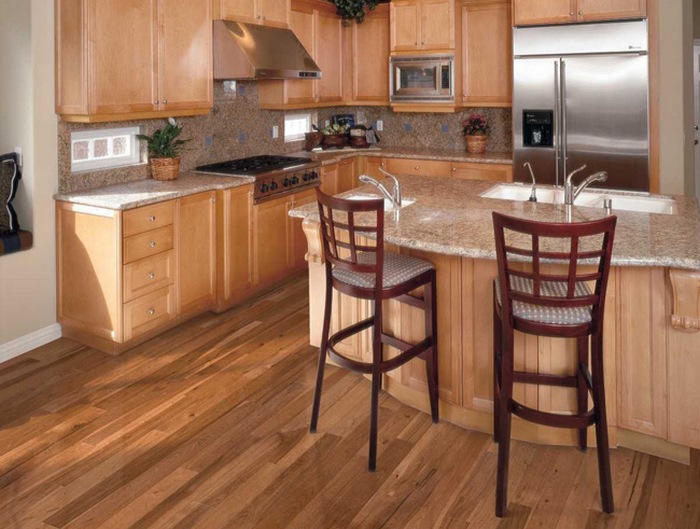
- In the first case, the thickness of the protective layer is 0.6 mm. This allows you to lay linoleum in places of high traffic of people and at the same time the flooring will remain invariably attractive. Here the wear resistance class will be 33 and higher.
- Household linoleum has a smaller layer of protection equal to 0.3 mm. Such material is used in rooms with less load. The wear resistance class of such a coating is 21-23.
- But there is also semi-commercial linoleum, the thickness of the protective layer of which is 0.4-0.5 mm. It is this coating that is most acceptable for the kitchen. Lay in kitchen area better linoleum class 31-32. This kind of flooring is good decision in terms of combining the qualities of household coverage with operational characteristics commercial linoleum.
Important: as additional protection for linoleum, the technology of applying another protective layer is used, which makes the material even better. It has such a layer like a varnish and is applied over a wear-resistant layer. This protection prevents the penetration of kitchen debris (water, grease, soot) into the structure of the floor covering.
In addition, it is worth knowing that all types of linoleum can have such protective layers:
- natural linoleum - linseed oil. It is an excellent antiseptic and prevents the growth of pathogenic bacteria on the kitchen floor.
- Matte and glossy varnishes for PVC linoleum. Create protective film on the floor surface.
- Impregnation of linoleum with silver ions. Evaporating into the air, such silver particles disinfect air masses in the kitchen and prevent the growth of bacteria. Laying a coating with such a protective layer on the kitchen floor is very practical.
What to look for when choosing linoleum
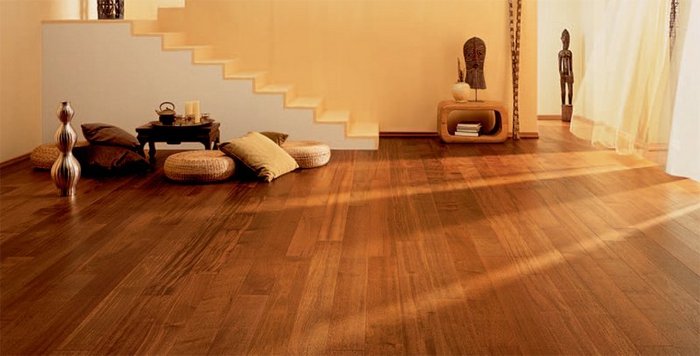
If you choose linoleum, but abandoned tiles or laminate, then you need to consider the following nuances:
- For different manufacturers linoleum quality and pricing can have significant differences. So study everything carefully. specifications material before buying and laying it.
- Give preference to the rough surface of linoleum, which will protect against slipping and subsequent falls on it. Laying such a coating on the floor in the kitchen is very convenient.
- In order to avoid unsightly joints when installing linoleum, it is better to choose a material according to the width of the room. It is better to buy a large width and cut it than to buy linoleum of a smaller width and then lay it end-to-end.
- If you buy linoleum in cuts (this sometimes happens), then make sure that the rolls are from the same batch. Otherwise, you will lay a coating with different color shades.
- Transportation of linoleum is best carried out in the form of a roll. And before laying it is better to let the material lie down at room temperature within 2-3 days. If you follow these rules, then linoleum will serve you for a long time.
Linoleum colors
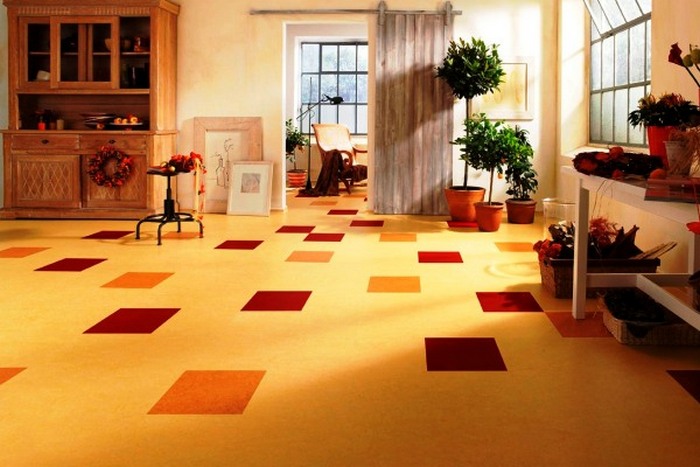
To create an unusual design in the kitchen, you can and should use popular color solutions linoleum.
So, one of the most interesting and sought after is linoleum under porcelain tiles. Moreover, you can find a coating both with the image of small tiles, and with the image of wide tiles. Which is better is up to you.
Another direction in the colors of linoleum is the imitation of laminate. Moreover, the laminate can be depicted as two-strip, and three-strip or single-strip. Shades of wood laminate can be very different - from dark wenge to light aged oak. Why not laminate in the kitchen, if you want to distinguish yourself and make unusual design premises!
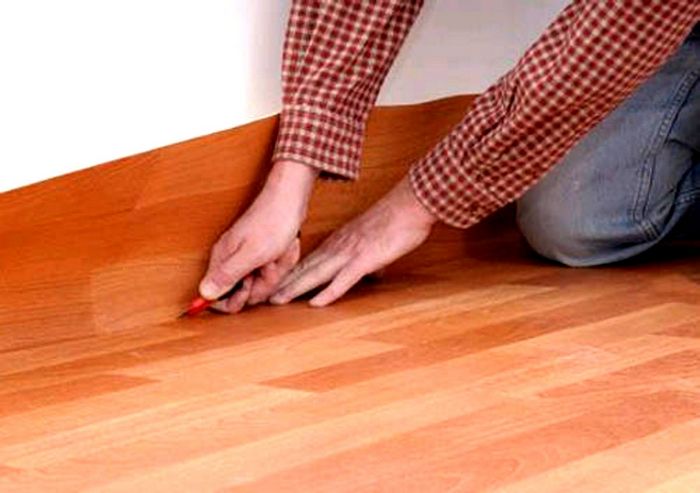
Linoleum with imitation massive board Perfectly fit into the kitchen in the style of country or Provence. Agree, significant budget savings on the purchase of natural floorboards.
The most popular flooring in Russia is, according to statistics, linoleum. It's cheap and durable material which is also easy to maintain. Ceramic tile takes only the third place, giving an honorable second place to the laminate. But when it comes to the kitchen, few decide to buy a laminate, because this material is afraid of moisture. So, you need to determine which is better - tiles or linoleum for your kitchen.
Which is better - tile or linoleum
Advantages and disadvantages of linoleum
This flooring is made of polyvinyl chloride, which is heterogeneous and homogeneous. Heterogeneous polyvinyl chloride consists of several layers. The first (lower) layer is a base made of felt, polyester, jute, PVC. The second layer (there may be several) is fiberglass, foamed vinyl. The third (top) layer is a transparent layer of heavy-duty vinyl.
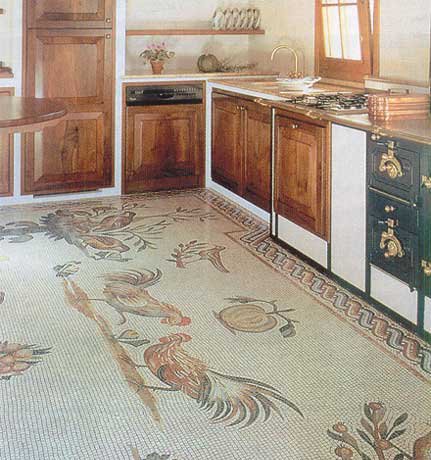
Linoleum for the kitchen
The advantages of linoleum
- Large variety of designs and colors. Any hardware store will offer more than 20 options for this coating, and its color will be whatever your heart desires: with geometric shapes, patterns, marbled or wood effect, tile or laminate.
- Linoleum is inexpensive. The lower price threshold is from 120 rubles per running meter.
- It is very simple to work with the material, even a person who is far from repair work.
- Linoleum is easy to care for, it does not require any special detergents.
- The material is pleasant to the touch, not as cold as tiles. The floor, covered with linoleum, is resilient and at the same time quite soft. The coating is quite durable, especially when it comes to wear-resistant linoleum.
- Linoleum, designed for places with high traffic of people, serves for decades without losing its attractive appearance. Household linoleum will also last quite a long time if handled carefully.
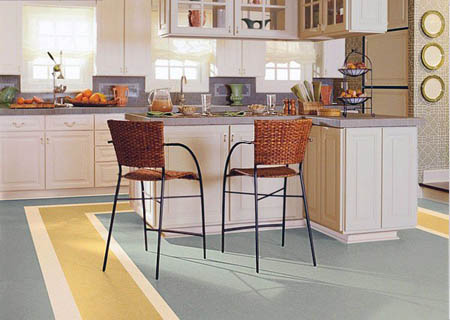
Linoleum for the kitchen
Cons of linoleum
- If there is a lot of sunlight in the room, any linoleum can lose color (fade in the sun).
- The material is not resistant enough to mechanical influences. If a knife or fork falls on it, or if you walk on it in stilettos, this can cause damage to the flooring.
- Linoleum does not tolerate temperature changes.
- There may be spots on it. For example, grease, acetone, paint and other unpleasant substances are washed off the surface of linoleum very poorly. But the stain will not appear if you instantly react and wipe off what has dripped or spilled.
- Linoleum is afraid of chemicals. It can be spoiled by some aggressive detergents. There are stains, stains, and even bald spots, so use only products designed for linoleum to clean the floor.
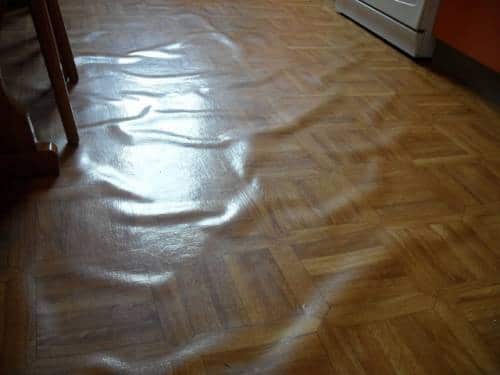
Poorly bedded linoleum can ruin the interior
Ceramic floor tiles in the kitchen
The kitchen is considered a high-traffic area, which is why many people use ceramic tiles as flooring. Consider the advantages and disadvantages of this material.
Advantages of ceramics
- Tiles are much stronger than linoleum. It can serve for decades, and at the same time its appearance will remain attractive.
- Huge range of colors and textures. AT construction stores you can see not only ceramic tiles, but also different kinds porcelain tiles, and glass tiles. Ceramic tiles can be matte or glossy surface, decorated with a pattern imitating wood, stone, metal.
- Ceramic tiles are resistant to temperature changes, so they can be installed both indoors and outdoors (for example, on a porch or an open terrace).
- The moisture resistance of the material is high. The tile will easily endure any flood, if one happens.
- The tiles are stain resistant and chemicals. It will be easy for you to take care of the floor on which the tiles are laid, because the material is not afraid of any chemistry, and stains “do not stick” to it.
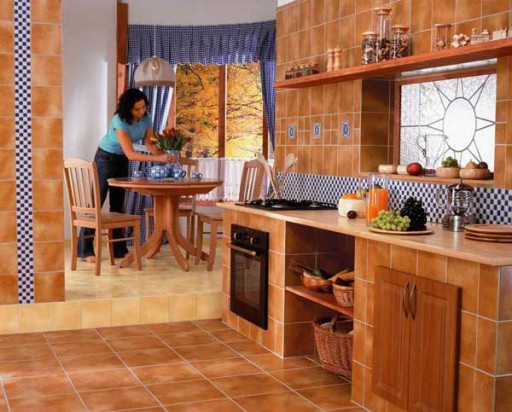
Tiles in the interior of the kitchen
Disadvantages of tiles
- Despite all the benefits, tile also has a number of disadvantages. And chief among them is her coldness. You can heat the tiles only by installing the "warm floor" system.
- High (compared to linoleum) price. Sometimes, floor tiles cost a lot of money to buy, especially if you are buying expensive quality tiles rather than cheap Chinese knockoffs.
- Tile is a rather difficult material to lay. And if not only a novice builder can cope with linoleum, but a person who is completely far from repair work, then only experienced master by tile. Installing tiles is a complex and painstaking job, and if you want them to be laid beautifully, you will have to pay not only for the tile itself, but also for the work of a specialist.
- The grout quickly loses its appearance. If the tile retains an attractive appearance for decades, then the grout for tile joints fails quickly enough. Therefore, use a darker grout, and choose special means to care for tile joints. SILIT BANG spray is excellent for tile care. It removes mold and all sorts of dirt. It should be sprayed onto the tiles and grouts, left for 10 minutes and rinsed off with water.
- Risk of injury. If a nimble child running through the kitchen falls on the linoleum floor, it will not hurt as much as falling on the tile floor. In addition, the tile, on which water is spilled, becomes very slippery. But most manufacturers have already paid attention to this, and in order to eliminate the problem, they create tiles with a special relief coating. Thanks to him, you can feel confident even on a wet floor.
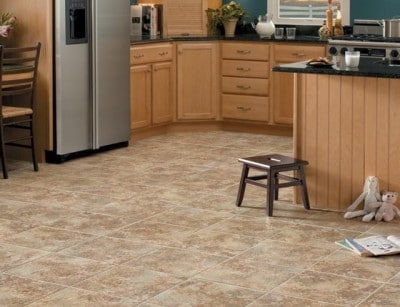
Tiles are a beautiful and durable material.
Which is better - tiles or linoleum: we draw conclusions
Summarizing all of the above, it can be noted that both materials are suitable for laying in the kitchen. However, linoleum may fail rather quickly, because any unfortunate fall of heavy and sharp objects, which are used in abundance in the kitchen, can cause damage to it. The same can be said about stains. A sandwich, spilled juice, coffee, or hot oil can stain.
Tile - finishing material, which is ideal for the kitchen, if you do not take into account its coldness. Although, if you walk in home shoes, you don't care. Most importantly, buy tiles with matte surface as glossy can cause injury.

The combination of tiles and linoleum on the floor in the kitchen
Thus, the tile is stronger, more reliable and more durable than linoleum. But this does not mean at all that linoleum cannot be used in the kitchen. You just have to be careful with this cover. Or you can even combine these two materials by putting in working area durable tiles, and in the dining room - pleasant to the touch linoleum.
